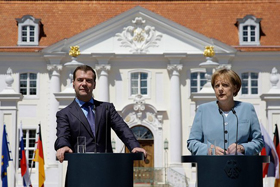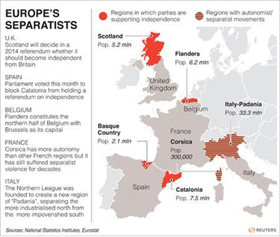Europe 2020: What's in Store for Integration?
In
Login if you are already registered
(no votes) |
(0 votes) |
Director of the Institute of Europe of the Russian Academy of Sciences (IE RAS), RAS Corresponding Member, RIAC member
Several decades ago, the EU integration project was geared at solving long-term problems such as the “pacification” of Germany, creating a common market and common currency, and engagement with East European nations. Appropriately, predictions regarding EU development were built on broadly understandable criteria. Today, the EU lacks a distinct vision of how it will develop, making forecasting an increasingly acute task. However, the accuracy of any forecast weakens with more unknowns coming to the surface.
Predictions do not often come true, a phenomenon that is more due to information excess – rather than its shortage. Causal relationships and the laws of history do help us peep into the future, but the “onward march of history” is affected not only by palpable events, but also by volatilities, black swan events that can obliterate the determinist approach to this kind of academic forecast. Event-based situations, chance and the role of personality (a subjective factor) converge to defy the logic of development. People often mistake chance events (if these are not natural and manmade disasters) with those that are formed beneath the surface of day-to-day events, hidden from the eyes of a distracted observer, shaped by history. In many, although not all cases, occasional and regular events become interconnected and can be represented like two sides of the same coin.
In the modern history of Europe, on the subjective side we have internal factors such as Mikhail Gorbachev (in the breakup of the USSR), Jacque Delors (in deeper European integration), Margaret Thatcher (Britain’s neoliberal reforms), Nicolas Sarkozy (in unleashing the Libyan war), etc., or external factors, for example George Bush Jr. and his neoconservative (neocon) policies that have expedited the autonomization of EU foreign policy. The objective factors include the disintegration of the Soviet Union, the 9/11 terrorist attacks, collapse of constitutional referendums in France and the Netherlands in 2005, and the global economic crisis that started in the United States. As for man-made environmental natural disasters that can be counted as chance events of historic magnitude, we have the 1986 Chernobyl disaster or the consequences of the 2011 tsunami, in which had a particular impact on the development of the European nuclear power sector.
The further the time horizon is from the scholar, the higher the risk of an inaccurate forecast. Foreseeing events one year ahead is quite different from developing a 10-year outlook, let alone envisaging a more distant future. Local, regional and global processes, as well as decision-making become faster, while overt and covert mechanisms multiply to cause the superimposition of various factors that have an effect on history. As a result, time becomes compressed, complicating the extent to which our analysis can probe into the future to the extent that what started as academic forecasting ends up as primitive guesswork. However, science still retains an important function in forecasting, which, with certain assumptions and caution, retains its significance, especially in an environment where the price of an error in governance is growing inexorably – in parallel with our hunger to see into the future.
Some forecasts aim to change the future and are rendered useless if the powers that be fail to heed them. A negative prediction would push people to take account of the concerns it raises, alter their course of action, and push events along a healthier path. In this case, the forecast risks become a self-fulfilling prophecy that changes the course of history. In other outlooks, the outcomes seem inevitable, and the only room for maneuver involves optimizing benefits or minimizing losses within a relatively narrow corridor of possibilities. Predictions make little sense if the decision-makers fail to use them in practice.
The fundamental problem in harmonizing this forecast and decision-making at a political level lies in politicians' short-term thinking. Their vision is limited to short electoral cycles, and they view the world in small packages of a few years each, whereas many problems require strategic planning for several decades. This contradiction is vividly exemplified by the global coordination of efforts to prevent the greenhouse effect or protect the environment.
Eurozone forecasts have been repeatedly revised, with even short-term scenarios becoming a mechanical compilation of various different scenarios all fraught with a host of variables.
In the European Union, the situation is complicated by a problem that arises from the sovereignty pool, i.e. the partial delegation of national sovereignty to supranational governing bodies. On the one side, the formation of a common European policy zone (within the EU) suggests a certain permanence, and the ability to speak with one voice. The natural consequence of this would seem to be greater predictability once universal rules of the game encompass more fields of life. But on the other, decision-making becomes vague and responsibility is eroded, because national politicians find themselves between the hammer of the electorate that will decide their fate at the next elections and the anvil of policy recommendations from the supranational that will almost inevitably clash with the voters' demands. As a result, it is becoming increasingly difficult to predict how any such construction may develop, or how the leaders, caught between a rock and a hard place, should act.
The most striking recent example seems to be the situation with the Eurozone as a whole, and in particular with its most troubled members Greece, Spain, Portugal and Italy, The electorate would like to see a softening of the austerity policy, while these supranational structures insist on further belt-tightening, making it difficult to predict how national politicians will act, even in the short term. The emergence of technical governments that run their countries in absence of a democratic mandate before the new elections has become a noticeable trend. This was the case with Greece until May 2012 and Italy until 2013. As a result, Eurozone forecasts have been repeatedly revised, with even short-term scenarios becoming a mechanical compilation of various different scenarios all fraught with a host of variables.
In terms of expansion, the coming decade is likely to see the EU admit all the West Balkan states except Bosnia and Herzegovina, Albania and Kosovo.
Bearing in mind the organization’s complexity and, to a great extent, ineptitude, which multiplies with every wave of expansion, the EU can only develop if it has a strategic vision, and in line with a long-term plan. It cannot afford to approach this “blind.” An incremental approach to handling problems – the small-steps policy – will only work if all team members share a clear-cut vision of the development targets. But if these tactics are formed into a strategy, sooner or later the integration project either stagnates or dissipates.
Several decades ago, the project was geared at solving long-term problems such as the “pacification” of Germany, creating a common market and common currency, and engagement with East European nations. Appropriately, predictions regarding EU development were built on broadly understandable criteria. Today, the EU lacks a distinct vision of how it will develop, making forecasting an increasingly acute task. However, the accuracy of any forecast weakens with more unknowns coming to the surface.
In terms of expansion, the coming decade is likely to see the EU admit all the West Balkan states except Bosnia and Herzegovina, Albania and Kosovo. Iceland will join, while Norway and Switzerland are likely to preserve the status quo, since they de facto enjoy the benefits of membership. This will draw a line under that. Other states which had been promised entry (i.e. Ukraine, Moldavia, and the Caucasus), should make do with achieving “associated status” that binds them securely to the EU while leaving them outside it. A great deal should depend on integration processes in the post-Soviet space. If, over the coming years, the Eurasian Union becomes a reality and forms its own field of gravity, growing into a successful, attractive organization, the EU’s eastward expansion will come to a halt. Under this scenario, we can cautiously expect Ukraine to fall apart into its eastern and western parts.

Victor Nadein-Raevsky: Search for Turkey’s new
identity and foreign policy
Turkey makes a special case. There is no precedent in EEC/EU history has of a candidate country (Turkey obtained the status in 2005) remaining unaccepted. However, this does not mean that it is impossible, with Turkey an obvious frontrunner for the unenviable position. It still has a chance of joining, although after 2020. Its admission would be unique for two basic and several quantitative reasons. First for geographical and cultural-civilizational reasons: Turkey is the first candidate country almost fully located in Asia, and the first country with a predominantly Muslim population, with all the appropriate mental, cultural and behavioral features.
Second, there are issues such as its population, lower material wealth compared with the European average and ambitious politicians, which together presages a major perestroika within the EU – virtually changing its nature. If Turkey comes on board, some scholars predict collapse, whereas others envision a fresh breath that would save the EU from failing in its attempt to become a leading center of influence in the 21st century. In fact, both may turn out to be right, but that would hinge on when the decision to admit Ankara is made.
The 2020s seem the best time for this, as the European Union should by then have stabilized after this current wave of political, socio-economic and financial crisis, and will have gone through a period of consolidation on the basis of the Treaty of Lisbon and the Treaty on Stability, Coordination and Governance within the Economic and Monetary Union. Turkey should retain sufficient political will to join against the backdrop of domestic Euro-skepticism.
If Turkey comes on board, some scholars predict collapse, whereas others envision a fresh breath that would save the EU from failing in its attempt to become a leading center of influence in the 21st century.
Should Turkey’s entry fail to take place, the global and regional balance of power will develop against Europe's interests and Turkey will grow to become a full-fledged regional leader. Therefore, Ankara should choose to retain a free hand and withhold its sovereignty from Brussels. Thus, we have two scenarios, both equally likely and both hinging on the time factor. But even if the first comes to pass, which is a train of events most in the EU’s interests, (at least as proponents of Turkey’s admission see it) this massive task will not create a new EU mission. Whereas until now the Union’s medium- and long-term goals, including expansion, have been shared by all member-states, the Turkey issue does more to fuel divisions than to foster unity among EU countries.
Predictions rarely presuppose inevitability, and history is full of surprises. In this case, the scenario method is viable as it offers different alternatives for the future which can be assessed against their relative probability. Without being ranked by probability, scenarios are meaningless and lose their prognostic role. Besides, scenario-based forecasts should be regularly adjusted to the changing reality. Scenarios are also pointless if they reflect a speculative approach to the research. They should not turn into a collection of custom-arranged facts and loose interpretation, rather they should offer a potential version of events that is likely to come to pass.
For example, there is practically no sense in considering the widely-discussed scenario of the EU’s collapse, nor is there any point spending much time on the opposite scenario: its emergence out of the crisis as a super-state. These two options are highly unlikely and do not deserve serious attention. The corridor of reliable variability for EU development seems much narrower, and includes principles such as two-speed Europe, variable geometry and permanent structured cooperation, i.e. the mechanisms that allow Europe to integrate in a more flexible, adaptive, stable and ergonomic manner.
Forecasts and scenarios cannot be used as a projection of one’s own (or collective) viewpoint on history, since they inevitably lose value. As in any well-grounded research, forecasters should strive to maximum impartiality and not express either their own desires or those of their clients.
The Union is in for a painful readjustment of its social market model, as in the absence of a rise in competitiveness, the EU will not become a 21st-century leader.
In the absence of any substantial forecast, a development program for a country or international organization would be reduced to rhetoric. This was of the reason behind the failure of the EU’s economic development program for the period to 2010 (the Lisbon Strategy), which hinged on a linear vision of history. Its conceptual mistake must have been in the mechanical projection of a lengthy upswing in EU development, rather than questioning the continued period of unprecedented growth.
One can forecast with a relatively high level of certainty that the EU will concentrate on solving its internal problems in an environment of high economic, social and political risks until late this decade. The Union is in for a painful readjustment of its social market model, as in the absence of a rise in competitiveness, the EU will not become a 21st-century leader. Forecasts based on World Bank calculations indicate that the 27-member EU’s share of the global GDP PPP is to fall from 20.8 percent in 2007 to 18.6 percent by 2020, and to 15.5 percent by 2030. The same figures for the United States are 19.4, 18.3 and 16.6 percent, for Russia – 2.9, 3.1 and 2.7 percent, whereas for China – 10.1, 17.7 and 22.7 percent, and for India – 4.3, 6.9 and 8.7 percent [1].
Demography and migration trends also seem to be running against the EU. However, disintegration under the burden of current problems is essentially out of question, with the probability of the Eurozone’s collapse also quite low. The euro is sure to remain the second reserve currency, while the recent rules governing its operation will undergo drastic changes, which is already underway in view of stricter membership criteria. A change in configuration, that is a division into front and rear groups, also seems likely. As of today, there seems little to substantiate a highly probable scenario in which a particular state leaves the Eurozone and reinstates its national currency. First, there are no withdrawal mechanisms, and, second, the negative effects and imperceptible consequences outweigh the positive expectations both for the responsible states and the entire group. References to the fact that the Greek economy accounts for just two percent of the EU’s GDP are inconsistent, as they omit both the multiplier and domino effects: if Greece, not to mention larger states, should leave the Eurozone, the damage will be much heavier. Another example of negative consequences due to this neglect of the multiplier effect is the mega-expansion of the EU, with 10 states joining in 2004, Bulgaria and Romania in 2007, and Croatia in 2013.
Proceeding from quantitative parameters, the EU was supposed to easily absorb new members, while the adoption of the European Constitution seemed a ”fait accompli.” Brussels was “dizzy from success” until the mid-2000s to cause a softening of the Copenhagen admission criteria, sugar-coated forecasts and excessive optimism. But now it has become clear that the EU will take at least till the end of this decade to adjust to these conditions, including the dramatically expanded membership.

Defend the welfare state: Trades Unionists protest
in London, London, UK, 2010
The crisis phenomena have sparked snowballing euro-skeptic sentiment inside the EU, polarization of the political party systems, and increasingly potent centrifugal trends. We are witnessing the rewriting of the social contract that underpinned the development of the West and Central European countries after the Second World War. The West European social market and the welfare state are going through a difficult time but are not likely to cede ground to the Anglo-Saxon development model as in the U.S. version. The systems will become less generous but will remain, at least in the Scandinavian and the Rhine-Alpine sub-models. However, the socio-economic imbalance within the EU will grow, as will social inequality in most member countries. By mid-2012, governments in about a dozen countries changed as a direct or indirect result of growing social tensions and massive discontent about social spending cuts. The process should continue, making electoral defeat of the ruling parties in Germany in 2014 and Great Britain in 2015 real possibilities. The victories of Françoise Hollande in France and the left in Greece seem to have launched another leftist wave in European politics.
We may forecast further shifts toward the democratization of the EU, which from the very start had been a project of political elites. Today, the democracy deficit problem is so grave that in the absence of its solution, action to stabilize the situation seems impossible. The role played by the European Parliament will continue to grow, with the establishment of the first pan-European political parties likely to take place by 2020. As a side-effect, this process will enhance friction between the European Parliament, European Commission and European Council.
In the years to come, the EU should keep moving toward integrating financial, budgetary and fiscal policies, a tendency already underway – and visible in the European Semester, Euro Plus Pact, European Stability Mechanism, and the Treaty on Stability, Coordination and Governance. Eurobonds, until now stubbornly rejected by Berlin, or project bonds, their milder version targeted at financing large infrastructure projects in the EU, are likely to appear.
Thus, the relatively lengthy expansion period should be followed by a deepening of the integration process, i.e. EU consolidation. The European Union is at or even past the threshold of its second reset after adoption of the Single European Act in 1986 and the Maastricht Treaty in 1992. The EU is returning to the federation of national states motto and the communitarian approach. Evidently, these policy areas are inseparable from the political component. In other words, financial and economic integration should catalyze the political process. As result, it seems almost inevitable that a two-speed Europe will be created, with the various countries divided into two groups: those focused on the EU’s interstate nature and those ready to reinforce its supranational character. Hence, consolidation will go hand in hand with the organization's internal differentiation that might even have an impact on the configuration of its borders.
In the coming decade, one cannot exclude the possibility that two states will emerge in the territory that has hitherto been Belgium, or that we will see an independent Scotland and a united Northern Ireland and Republic of Ireland somewhat further down the road. Spain will continue pursuing federalization, while Catalonia is to remain part of it in the foreseeable future. Changing borders would not only create division but also the emergence of new territories. After 2020, the prospects of Moldova (less Transdniester) attaching to Romania (and the EU) and Kosovo to Albania seem quite likely.
The relatively lengthy expansion period should be followed by a deepening of the integration process, i.e. EU consolidation.
The Common Foreign and Security Policy and Common Security and Defense Policy (CSDP) can be expected to lag seriously behind the financial and economic trends, and the CSDP to an even greater degree. Nevertheless, the further autonomization of the EU as a global political force is an objective and hence irreversible process, which brings Russia both plusses and minuses. The EU’s transformation into a more consolidated international actor will help Moscow in areas where the sides' interests coincide, for example on the UN’s central role in global relations, polycentricism, coalition-based decision-making taking BRICS interests into account, and conflict resolution in regions adjacent to Europe (North Africa, the Middle and Near East).
By 2020, a visa-free regime should have been established, with the new basic agreement to be concluded by the middle of the next decade.
At the same time, Moscow will find it harder to employ privileged relations with certain European capitals on matters where interests diverge, such as the EU Eastern Partnership, conflicts in the post-Soviet space, and influence in Central Asia. The issue of frozen conflicts remains highly politicized and thus complex for prediction. For example, activities to settle the Transdniester issue risks aggravating relations between Russia and the European Union but could also offer a new chance of forcing progress in their interaction.
Remember that the CSDP’s development runs in parallel with the reinforcement of the EU’s hard force tools, which puts Russia in a conflicted position. Any kind of military buildup along borders of Russia and the CSTO states is rife with additional risks. At the same time, the transformation of the EU into an effective military and political actor might stimulate cooperation between Brussels and Moscow in this sphere and create new joint peacemaking missions, at least in regions where the sides do not have rival claims to “zones of influence.”
Moscow will, most likely, see a narrower space for maneuver in relations with Brussels, including regarding oil and gas deliveries, especially after the likely emergence of the common EU energy policy in years ahead. To this end, further efforts are needed to establish permanent coordination and harmonization mechanisms, including the implementation of the Meseberg initiative of Dmitry Medvedev and Angela Merkel (the Russia-EU Committee on External Policy and Security) and the Energy Union. The latter no longer seems improbable against the backdrop of current tensions, since by 2020 the sides’ interdependence in energy supply should only strengthen.

Office
German Chancellor Angela Merkel and Russian
President Dmitry Medvedev speak to the media
following bilateral talks at Meseberg Palace on
June 5, 2010 in Meseberg, Germany.
There is virtually no alternative to the continued development of the Russia-EU strategic partnership concept. By 2020, a visa-free regime should have been established, with the new basic agreement to be concluded by the middle of the next decade. Normal relations between the EU and the Customs Union on the WTO foundation seem quite likely. After Russia joins the organization, talks on a new basic agreement may advance to the WTO-Plus concept, which provides for the creation of an unprivileged free trade zone by the two sides.
Hence, the 2020 forecast for the EU is almost free from any real disaster scenarios. There seems very low probability for the collapse of the integration project as a whole and only a slim probability that this will happen to the Eurozone, its subsystem. We predict the likely stabilization of the domestic political and socio-economic situation by the end of the decade, and further autonomization of the EU as an economic and political actor beyond that. This is not to indicate that new crises will not surface, both at the state and supranational levels. One may also reasonably suppose that, in the foreseeable future, the EU could become even further submerged in solving its internal problems and settling domestic squabbles, which show scant sign of dissipating.
We do not exclude a stagnation or inertia scenario that would hinder the EU’s return to growth. The emergence of potential for boosting Europe’s global influence once the period of stabilization has been completed will depend on the EU’s and Turkey's ability to reach consensus on Istanbul's admission by the early 2020s. The European Union's capabilities as a global center should expand (especially if Turkey remains outside) provided partnership with Russia continues to boast substantive content. This scenario would be equally beneficial for Moscow.
Note
1. Europe 2030 / Ed. by Daniel Benjamin. Brookings Institution Press, Washington, D.C., 2010. P. 65.
(no votes) |
(0 votes) |






